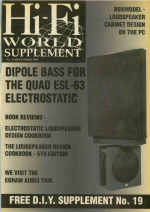Attachments
I know quite a lot about the SL6000 and its sub having worked closely with the designers and also attempts to 'improve' it. Don't think it's the ideal sub for ESL63
But thanks for digging this up Steve. Brings back many happy memories,
But thanks for digging this up Steve. Brings back many happy memories,
This article was the starting point of my dipole journey! Described is also the electronic crossover with one FET transistor VN10KM that i used later. Sounded great!
Did you cover Gradient already? By ~1990, there was also the Gradient SW-63 dipole sub designed for the Quad ESL-63 to sit on.
https://www.inner-magazines.com/audiophilia/a-brief-history-of-gradient-labs/
https://www.inner-magazines.com/audiophilia/a-brief-history-of-gradient-labs/
Thanks Andersonix for the Gradient ariticle. I had a lot of discussions with Anders & Jorma in Jurassic times.
My take on their 1983 AES Montreux paper is AbsoluteListening Tests-Further Progress in which I coined the term Room Interface Profile. This is probably the biggest factor for speaker sound quality. I've spent nearly half my life trying to get a handle on this without success though I can certainly pontificate at length (like da False Prophets Toole & Olive) to impress da punters.
The tech behind my dipole 'solution' to this is sorta described in "LOUDSPEAKERS and the STEREO IMAGE" - GP Millward, HFN & RR nov84 though that concentrated on the stereo aspects of dipoles (and other directivity patterns).
The practical embodiment of this sh*t was Option 1. This mythical beast was a powered speaker with 600W built in. It was dipole down to 35Hz but you could switch in a 90 ltr ported sub to extend the response to below 20Hz. On most music, this would not change the timbre of the sound but stuff like cellos & basses would 'change shape' as they played down the scale.
I designed this soon after doing the Mk4 Soundfield Microphone and I've been accused of designing both to suit the demands of Ben Britten's War Requiem ... for which I'll remain silent on the grounds that I might incriminate myself 😊
This is unfinished business for me ... which is why I asked bolserst if he could do FEA/BEA of ELS speaker in rooms
My take on their 1983 AES Montreux paper is AbsoluteListening Tests-Further Progress in which I coined the term Room Interface Profile. This is probably the biggest factor for speaker sound quality. I've spent nearly half my life trying to get a handle on this without success though I can certainly pontificate at length (like da False Prophets Toole & Olive) to impress da punters.
The tech behind my dipole 'solution' to this is sorta described in "LOUDSPEAKERS and the STEREO IMAGE" - GP Millward, HFN & RR nov84 though that concentrated on the stereo aspects of dipoles (and other directivity patterns).
The practical embodiment of this sh*t was Option 1. This mythical beast was a powered speaker with 600W built in. It was dipole down to 35Hz but you could switch in a 90 ltr ported sub to extend the response to below 20Hz. On most music, this would not change the timbre of the sound but stuff like cellos & basses would 'change shape' as they played down the scale.
I designed this soon after doing the Mk4 Soundfield Microphone and I've been accused of designing both to suit the demands of Ben Britten's War Requiem ... for which I'll remain silent on the grounds that I might incriminate myself 😊
This is unfinished business for me ... which is why I asked bolserst if he could do FEA/BEA of ELS speaker in rooms
